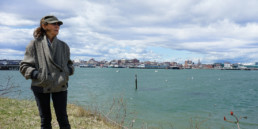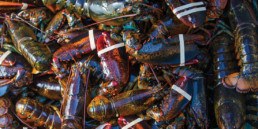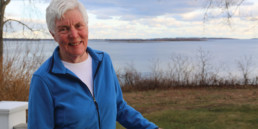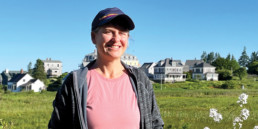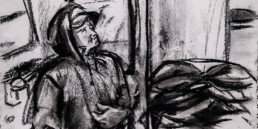Trading Sardines for Lupines
Eastport’s rebirth may portend a new kind of rejuvenation
By Rob McCall
The sardine—a generic name for several types of herring—is the icon of Eastport, which likes to call itself “the easternmost city in the USA.” Eastport encompasses five islands, the largest being Moose Island. With a population of only about 1,300 people, Eastport still remembers its heritage every New Year’s Eve by dropping, not a sparkling ball, but a giant sardine from the roof of the tallest building on Water Street.
At its peak, Eastport had 5,000 people and dozens of sardine canneries in operation when the herring were running, and Eastport sardines were shipped around the world.We first came to Eastport in the mid-1970s, camping out on Cobscook Bay. We built a cabin on Leighton Neck in 1980. When I was called to serve as pastor of the Congregational Church in Blue Hill in 1986, one of the many enticements—along with fields of lupine—was that our camp was just a two-hour drive away. In the fall of 2014, we moved to Eastport to live there year-round, just in time for the coldest and snowiest winter ever recorded in the state.The golden age for Eastport ended in the 1950s as the herring dwindled, the canneries began to close down, and the city slipped into a depression, both economically and emotionally. There were few bleaker places along the Maine coast. In the 1970s, Tim Sample joked about an Eastport “Vacant Building Festival,” and quipped that if you could buy a Greyhound bus ticket with food stamps, there would be no one left in town. He could have said the same about most of Washington County.
~
Washington County’s population in 2010 was 32,856; the estimate for 2014 was 31,808, showing a decline of 3.2 percent. At 3,255 square miles, of which 695 square miles are water, the county is a good deal larger than Delaware. Due to the Native American population and a surprising number of Hispanic settlers who came to rake blueberries and stayed, the minority population is almost 10 percent, compared to about 6 percent for the rest of Maine, and less than 4 percent for neighboring Hancock County.
There are many conservation lands, notably Moosehorn National Wildlife Refuge, at over 28,000 acres; Cobscook Bay State Park, at 888 acres; and Quoddy Head State Park, at 541 acres, where you can hear the grumbling of softball-size rocks being rolled up and down the beach by wind and waves coming up the Grand Manan Channel.
Economically, about 20 percent of the people in the Sunrise County are living below the federal poverty line, compared to about 14 percent in Maine as a whole. According to Good Shepherd Food Bank, Washington County has a food insecurity rate of 17.6 percent, and 28 percent of county children regularly face hunger. Unemployment in 2013 was 7.7 percent, compared to 5.1 percent for the state. The suicide rate is 16.7 percent per 100,000, the third highest in the state.
~
Not long ago, I pulled into a gas station mini-mart way Downeast on Route 1 for a cup of coffee and a blueberry muffin. I parked next to an older, banged-up Dodge Ram pickup, covered with a coating of oil and dust. In the bed were rubber boots, a chain saw, some plastic fish totes, and numerous rusting tools—nothing unusual here, where the pickup trucks still outnumber the Subarus by about two to one.
What caught my eye was the vinyl lettering on the back window which read, “In Loving Memory of Lillian ————, 1975–2015,” with a photo beneath showing a haggard woman who could easily have been 65. With a bit of a shock, I said to myself, “I know her.”
She used to call on the church for help with food and fuel, but as often as she called for herself, she called for someone else—her disabled brother, her mother- and father-in-law, her grown kids, her friends. I knew she had struggled through rehab into recovery, and through chemotherapy into remission, but I didn’t know that her struggles had ended so soon. As desperate as her situation was, she always looked out for her family and friends with a fierce determination and persistence. She was a grievous angel of hardship in far Downeast Maine.
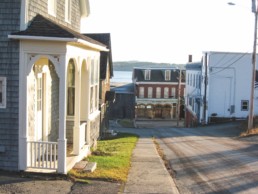
Why do people stay in Washington County? Not an easy question to answer. Certainly, some stay because they lack the ambition or the resources even to move out. Many more stay because of family ties, ancestral history, a wide freedom to live your life, good fishing and hunting, and for just the sheer raw beauty of it.
It is very hard to describe this land of high tides and leaping whales, of shattered rocks and ripping currents, of eagles and herons, to someone who hasn’t seen it. It becomes a part of you, and you become a part of it. Elsewhere, humankind has some semblance of control; here, nature still has the upper hand.
A living embodiment of that was Junior ————, who made his living on the clam flats year-round. The first time I met him he was coming up from the shore near our camp in his clean, but old, Toyota Tercel, with some cement blocks in the back to give it traction, and several hods of squeaking clams.
“I’ve been to the city, but I came right back. I wouldn’t trade this for anything,” he said, with a sweeping gesture of his arm toward the bay. “I’m my own boss, and I can pretty much do what I want to do.” What he wanted to do was earn enough to make a living and send his children to college, and to be outside winter, spring, summer, and fall. And that is just what he did.
That same self-sufficiency and independence shows itself when neighbor helps neighbor. It may be the coffee can on the checkout counter to help someone with medical bills, or the benefit supper to help the family whose house burned down, or the food pantries, yard sales, flea markets, or deer meat that is brought to someone who can’t hunt anymore. Compassion and hope are not dead. If anything, they burn brighter through hardship.
~
Comedians may wisecrack, but it is no joke when years of poverty from a collapsed economy bring high rates of domestic violence, suicide, and petty crime, along with despair and hopelessness and self-medication with alcohol and drugs to ease the pain. Drug use in Washington County has moved with terrifying speed, from the abuse of prescription opiates like OxyContin to the real thing: heroin. Most of us know the story. State funds for addiction treatment are drying up, and law enforcement is stretched to the limit, particularly here, where a small population is spread over a vast region, much of it in unincorporated areas and tiny towns without any police force. The county sheriff has only eight deputies patrolling an area half the size of Massachusetts.
I have a theory that Washington County may be a harbinger of all of postapocalyptic America. It has been overlogged, overfished, overworked, and overlooked. The former bounty of its rivers and forests and sea have been taken and hauled away to somewhere else; it has been exploited and left drained and depleted, like a lot of other places in our great country. But it will not roll over and die.
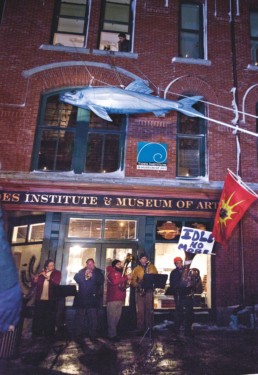
Musicians play in front of the
Tides Institute in downtown
Eastport.
Something new and startling has been happening here in this beleaguered region. After a number of false starts and dashed hopes over the years, Eastport is now a dozen years into a remarkable rebirth which may provide a model for other forlorn and forgotten places.
At its lowest, Eastport still had some resources: cheap real estate, a slower pace, soothing quiet, and breathtaking beauty, to mention a few. As all the other available coastal property was being bought up from Kittery to Machias, this area still had affordable old homes and saltwater farms, and people from elsewhere took notice.
Old houses have been renovated, vacant buildings have been filled, and Eastport is busier than it has been in 50 or 60 years. On any good day, the sound of hammers and saws echoes around the island, and trucks from the lumberyards rumble up and down the streets, delivering materials.
The exodus of young people has not stopped, but it is increasingly being matched by the influx of older people from away—lupine lovers. Many of these people have fled other parts of Maine, and the country, to find a slower, more human-friendly pace of life. People come from other places to be renewed. Many also bring talent and experience that can enrich the life of a community. Quaint and quirky shops open, galleries spring up, music and drama find a stage on which to appear.
On the back roads, farmers and market gardeners take hold, producing local food. Where before there was only despair and depression, now there are glimmers of hope. Maybe the apocalypse was not the end of the world. Maybe what we are seeing in Washington County is a contrast to the morbid Mad Max vision of postapocalyptic America: that is, a slow, gradual healing.
~
You could call this the Lupine Revolution, and it is happening all over Maine, but most dramatically in some of its hardest-hit towns. It is significant that the lupine is the totemic flower of Maine, especially since it is classified as an invasive species. Lupine is attracted to what botanists call “disturbed soils.” As an example, the lower fields on Blue Hill Mountain had been burned and sprayed with herbicides for commercial blueberry operations for many years, until the mid-1990s. All that grew there were blueberries; the herbicides had killed everything else.
The fields were eroded and rutted, the soil, depleted. When the land was put under conservation, the spraying stopped, and pretty soon the lupine took hold. For several years, the worn-out fields were blanketed with purple. People flocked to see the lupine, they took pictures, had picnics, weddings, and festivals.
Lupine is a legume which puts down a tough and deep root system with the ability to fix nitrogen in the soil where it grows. A stand of lupine moving into a field of worn-out soil will soon improve it so that other plants can move in too, both native and nonnative. After a few years, something strange happens: The lupine begins to shrink back to a few smaller patches while the native flora fills in and takes over. After a time a healthy, diverse flora and fauna are once more established and flourishing.
This is what the Lupine Revolution is doing in so many of our small coastal towns: rebuilding the soil, and the soul, of easternmost Maine.

